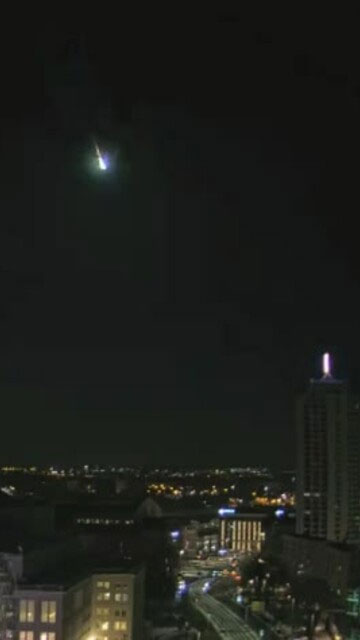Record-fast spinning asteroid crashes into Earth
2024 BX1, the asteroid that crashed into Earth on January 21, rotated faster than any near-Earth object ever recorded .
(Video: X/Denis Vida).
Asteroid 2024 BX1 turned into a fireball and exploded in the sky over Berlin, Germany, on January 21. Although small asteroids that collide with Earth are typically only detected once they enter the atmosphere, scientists detected this asteroid about three hours before the impact.
This isn't the only thing that makes the 2024 BX1 special. According to new research published on the arXiv database , it moves at a speed of 50,000 km/h and rotates once every 2.588 seconds. This is an unprecedented fast rotation speed in an asteroid near Earth, Live Science reported on May 2.
Previously, this record belonged to 2020 HS7, which rotated once every 2.99 seconds. This asteroid has a diameter of 4 - 8 m, slightly larger than 2024 BX1. This may be the reason why it spins slower than 2024 BX1.

The asteroid crashed into eastern Germany on January 21.
There are many reasons why asteroids rotate, such as being ejected back into space after a collision. Because they are more compact, small asteroids tend to rotate faster than large asteroids. "They have endogenous strength so they can spin faster ," said lead author Maxime Devogèle, a physicist at the University of Central Florida.
Devogèle and his colleagues studied the rotation speed of three asteroids, including 2024 BX1, with images taken when they approached Earth. The remaining two asteroids, 2023 CX1 and 2024 EF , were studied based on their approaches to Earth on February 13, 2023 and March 4, 2024.
A team of experts developed a new technique to determine the dizzying rotation speed of asteroids based on images. The method involves adjusting the size of the aperture - the hole through which light enters the camera - so that the starry background looks sharp and the asteroid rushing by looks like a streak of light.
Thanks to a long exposure time, the resulting image shows asteroid 2024 BX1 rushing through a starry sky. Changes in brightness along the path represent rotations of the asteroid and suggest it has an elongated shape. The research team measured the distance between these bright spots and concluded that the asteroid's rotation time is 2.588 seconds, equivalent to 33,000 rotations per day.
Understanding the rotation speed of asteroids flying near Earth will help minimize the risks they can pose to people and infrastructure.
- Asteroids challenge every law of gravity
- This afternoon, an asteroid will fly over the Earth
- Double asteroid threat
- The asteroid is about to fly closest to Earth in 115 years
- How will the world stop spinning and change the world?
- Nearly 600 meters asteroid will fly over Earth next week
- Detection of asteroid flying 30 times closer to Earth than the Moon
- Giant meteorite is about to fly past Earth
- A 2,000-meter asteroid could crash into Earth in the future
- Asteroid 800,000km2 fly near the Earth
- An asteroid has just crossed the Earth
- What kind of catastrophe will people suffer if the Earth stops spinning?
 Van Allen's belt and evidence that the Apollo 11 mission to the Moon was myth
Van Allen's belt and evidence that the Apollo 11 mission to the Moon was myth The levels of civilization in the universe (Kardashev scale)
The levels of civilization in the universe (Kardashev scale) Today Mars, the sun and the Earth are aligned
Today Mars, the sun and the Earth are aligned The Amazon owner announced a secret plan to build a space base for thousands of people
The Amazon owner announced a secret plan to build a space base for thousands of people